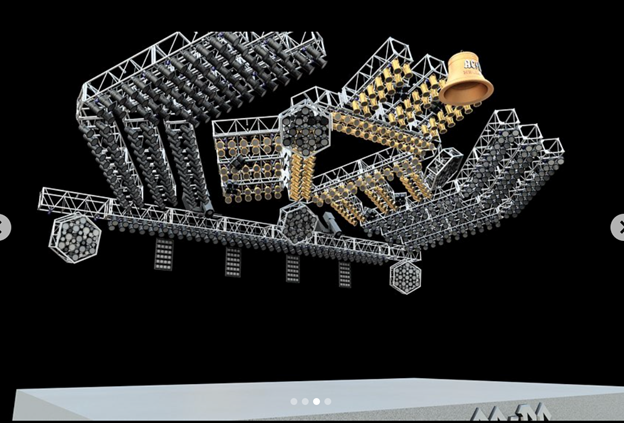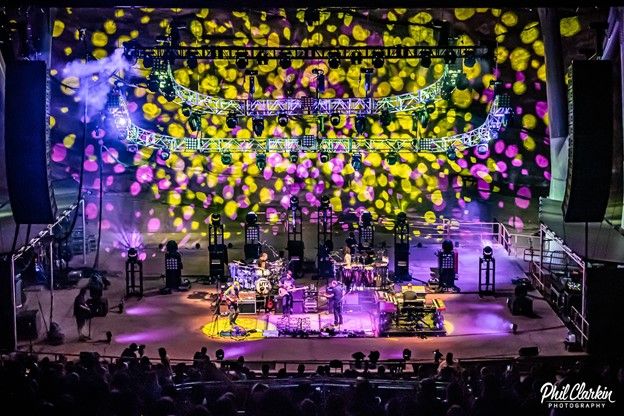Lessons Through Iteration
The Design Process for Lighting Umphrey’s McGee at Red Rocks

When I was hired by Umphrey's Mcgee three specific shows stood out. The first was New York City's, Beacon Theater, home to the iconic room that was only a short train ride away from where I grew up. The second was the Summer Camp Music Festival, a four-day festival in Illinois that Umphrey's essentially hosts, and the last - and by far most exciting - was Red Rocks Amphitheatre. Red Rocks is Colorado's gorgeous 10,000-person venue built into the natural landscape of the mountains. The atmosphere is simply breathtaking.
I had run lights as an opener at Red Rocks twice before, and funny enough, once with Spafford opening for Umphrey’s McGee. Working with an opener meant the light rig was limited in size, the sun was shining for the set (nullifying the impact of any lights), and they weren’t my designs.
Despite all its awesomeness, two key factors make Red Rocks a uniquely challenging venue for lighting designers. First, the audience seating ascends at a very steep angle, meaning that by the time you get about 30 rows up, most of the details of the lighting rig are cut off from the sightline. Any geometric aerial designs that would succeed in an arena or theatre do not translate to Red Rocks, a design type that I lean heavily on during a standard Umphrey’s show. The second challenge is the volatile weather. Constant changes in wind and humidity make for a terrible time trying to keep haze and atmospheric effects in control. I saw an industry peer that I admire post on an online forum that having a bad show at Red Rocks was a rite of passage for lighting designers.
I used these known challenges to inform my design process for Red Rocks and laid out a set of three goals for the rig:
Hold shape despite lack of haze: I wanted the rig to remain visually cohesive and engaging, even if the haze machine was off, which it would be for the beginning of each show.
Use lights that were big enough for the steep venue: Many fixtures project sharp, bright beams from a small source. With the above consideration, I prioritized physically large sources of light. I landed on this after an interview with the lighting designer for Red Hot Chili Peppers praised the K20 B-EYE for its technological prowess as size.
Create depth around the band, avoid standard horizontal truss orientation: ‘LIGHT THE BAND!’ was written in my notebook somewhere along the way…
To do this, I looked back on arena rock lighting rigs from the 1980s for inspiration. Haze and beams were not as present then as they are now, which I thought would be an appropriate reference for these shows. One design that specifically stood out was AC/DC’s 1983 tour. Without any lights turned on, the powerful rig's shape immediately draws in the viewer.

Using the inspiration from AC/DC, I came up with an initial draft.
It was denied for two reasons. The design was a bit over budget, and more importantly, the high winds at Red Rocks presented a safety concern with the three upstage pods. Considering how low they hung, there was a good chance the wind would swing them to a dangerous degree.
Taking this feedback, I headed back to the drawing board and came up with a second set of ideas.
While this rig was within budget and safe from a rigging perspective, I realized there were still issues after creating looks in the visualizer. The drop downs on the sides of each of the “U”s were going to be problematic once the rig was in the air as lights were blocking each other. One more round of edits was in order.
I thought the rig succeeded in achieving the goals I set out at the beginning of the process. The “U” structures hung in the air were cohesive and held their form from every angle in the venue. No matter the amount of haze, wind, or sightline blockage, the two “U”s were felt. The K20 B-Eye and Nexus Panel fixtures brought just the right amount of brightness for the large venue. I found myself operating at around 60% brightness for most of the songs, and when the band would pick up speed and energy, I utilized the extra 40% to turn up alongside them. Lastly, the shape of the ground package brought the depth I was seeking. Instead of effects simply moving left to right, effects would wrap around the band, utilizing the upstage/downstage dimension in addition to the left/right dimension.
The demanding nature of the venue and the uncertainty of show dates and scale made lighting Red Rocks the biggest creative and technical challenge of my career. It was difficult to find a consistent workflow amidst other shows, changing details, and COVID-induced mental stress and confusion. With that said, I am eternally grateful to have experienced this dreamy run of shows in the middle of a very intense time around the world.
Ben Factor is the lighting director for Umphrey’s McGee. He explores the ever-changing relationship between technology and music through his work. While operating the show, Ben leans on his background as a musician to help ensure the lighting is as tasteful and dynamic as the music on stage. He is based in NYC.

About Umphrey’s McGee
The music of Umphrey’s McGee unfolds like an unpredictable conversation between longtime friends. Its six participants—Brendan Bayliss [guitar, vocals], Jake Cinninger [guitar, vocals], Joel Cummins [keyboards, piano, vocals], Andy Farag [percussion], Kris Myers [drums, vocals], and Ryan Stasik [bass]—know just how to communicate with each other on stage and in the studio. A call of progressive guitar wizardry might elicit a response of soft acoustic balladry, or a funk groove could be answered by explosive percussion. At any moment, heavy guitars can give way to heavier blues as the boys uncover the elusive nexus between jaw-dropping instrumental virtuosity and airtight songcraft.
Umphrey’s McGee is a touring powerhouse, performing 85+ shows per year, headlining annual shows across the US, including Red Rocks Amphitheatre in Morrison, Colorado, and the Beacon Theatre in New York. Umphrey’s is a constant US festival staple, with performances at major events including Lollapalooza, Austin City Limits, Rothbury, and Bonnaroo, as well as international festivals Fuji Rock Festival (Japan) and Byron Bay Blues Festival (Australia). The band hosts their own festival in Illinois, Summer Camp Music Festival, where they perform three nights and have hosted the likes of Primus, Jane’s Addiction, Thievery Corporation, and Willie Nelson, to name a few. Umphrey’s McGee has also hosted and headlined Jam in the Dam (2005, 2006, 2008, and 2010), a three-night mini-festival at the Melkweg in Amsterdam.
Photos by Tara Gracer













